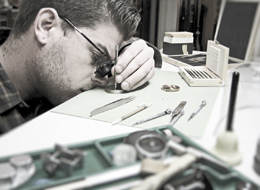 Keaton Myrick is in the time business, and with his profession building handcrafted wrist and pocket watches, hopes business keeps on ticking.
Keaton Myrick is in the time business, and with his profession building handcrafted wrist and pocket watches, hopes business keeps on ticking.
The 29-year-old master watchmaker from Bend is creating one-of-a-kind, precision timepieces out of his office at Beacham’s Clock Company in downtown Sisters. His enterprise, KM Independent Watchmaking, has an appropriately intriguing motto: “Fueled By Passion, Governed By Time.” It’s something the young craftsman takes very seriously. Each piece is conceived with painstaking attention to detail, melding old world techniques with modern age technology. Myrick plans on having a minor seat in the big game dominated by posh names like Patek Philippe, International Watch Company and Kari Voutilainen, whose stratospheric price tags rival most automobile window stickers or small houses.
“I’ve always had an interest in watches starting from a young age,” he said. “I even had a little Swatch watch collection, then got into collecting vintage watches. One day I found out through a watch magazine there were actually schools you could go to to learn the art.”
Myrick graduated from the prestigious Littitz Watch Technicum in Pennsylvania in 2007, a private trade school that accepts just 12 students per year out of an estimated 150 applicants from all over the United States. It’s a fairly new watchmaking school providing a two year program in fine watchmaking, earning him an impressive WOSTEP (Watchmakers of Switzerland Training And Education Program) diploma.
“One of the reasons I decided to apply is their emphasis on micromechanics,” Myrick explained. “Most people go to watchmaking school to learn repairs but I wanted to absorb it all. Part of their program is actually making a watch. Littitz is the only school in the United States that practices this tradition. If you can make it, you can fix it is their essential philosophy, knowing how each tiny part works and how they interact and relate to each other. I take a lot of pride in the WOSTEP badge, some of the best watchmakers in the world come from the WOSTEP tradition.”
After Littitz, Myrick went to work for Rolex for a year before making the difficult decision to follow his dream of manufacturing his own line back in the region he was raised. He set up shop in Sisters in the fall of 2009 amid the chimes and tickings of hundreds of antique timepieces.
The market for artisan watchmaking has blossomed in the past decade, providing opportunities to ambitious startups with the required talent and patience to craft a watch entirely by hand. Historically in England, master watchmakers would undergo a formal seven-year apprenticeship before joining a trade guild such as the Worshipful Company of Clockmakers in London.
“Mechanical watches are really popular right now. Our economy’s recent downfall has instilled in people the idea that disposable items are just that – disposable. You’re starting to see a shift toward a more well-made, quality item designed to last for decades, even centuries if maintained correctly. I think the watch is the ultimate heirloom. My product is a manual-wind, highly-finished, precision timepiece made in limited quantities one at a time. My goal is to craft 12 watches a year.
The hundreds of hours that goes into the creation of such a timepiece can put a strain on any social life
or relationship.
“I have a very understanding fiancee, Michelle, and she’s really patient and allows me to spend a lot of time doing this, knowing this requires many long day and nights in the shop to build the first series of watches and establish a line.”
All KM Independent Watchmaking cases are stainless steel and will eventually expand into precious metals of gold or platinum as the line progresses. The delicate movement is made of German silver because of the high level of lustre and finish it affords. It’s also a non-tarnishing metal that doesn’t require plating. Each minute and hour hand is made out of hardened and tempered carbon steel and can take up to twenty continuous hours to finish after the initial machining process.
“I like to show different finishing techniques and want to include flat or “specular” polishing that provides a mirror-flat surface, causing the light to flash off the surface instead of roll,” said Myrick. “Black polishing with diamond-micron paste delivers the illusion of it being polished so fine it gives the appearance of a black mirrored surface. I like to finish every visible component to such a degree that customers automatically assume the rest of the watch is crafted with that same level of care.”
Aware of the intense competition in his field, Myrick is active on social networking sites like Facebook which help share his passion for horology.
“I’m able to advertise in different and creative ways, displaying videos of how watches are made, pictures of manufacturing processes or finishing techniques, and hopefully ignite an interest in someone that wasn’t
there otherwise.”
“Right now I’m beginning the manufacturing phase of two watches and expect to have them done this year. I balance my time between restoration and repair of vintage watches and the manufacturing of my own line. That’s the beautiful thing, I’m an actual guy in a shop making watches, without some giant conglomerate dictating rules. What you often find in independent watchmaking circles is a tendency to push the envelope with more radical designs, taking risks and challenging yourself, utilizing traditional watchmaking techniques practiced for close to 500 years.”
Most people are familiar with premiere watch companies like Rolex, Breitling, Omega and Tag Heuer that sponsor major sporting events around the globe. Myrick think it’s interesting for people to learn that there’s this upper level of watchmaking that most never knew was there.
“These watches are part of our lives, we wake up in the morning and wind them and without our care they wouldn’t live,” he reflected. “The winding of a high-end watch is a very intimate relationship and we go to great lengths to ensure the act is an enjoyable one with design features made to be pleasing to the eye. We like to call it functional art, artwork that needs to do something and do it well. That’s my goal I continue to strive for.”
www.kmindependent.com.





